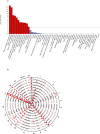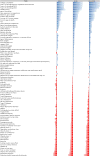Large-Scale Cognitive GWAS Meta-Analysis Reveals Tissue-Specific Neural Expression and Potential Nootropic Drug Targets
- PMID: 29186694
- PMCID: PMC5789458
- DOI: 10.1016/j.celrep.2017.11.028
Large-Scale Cognitive GWAS Meta-Analysis Reveals Tissue-Specific Neural Expression and Potential Nootropic Drug Targets
Abstract
Here, we present a large (n = 107,207) genome-wide association study (GWAS) of general cognitive ability ("g"), further enhanced by combining results with a large-scale GWAS of educational attainment. We identified 70 independent genomic loci associated with general cognitive ability. Results showed significant enrichment for genes causing Mendelian disorders with an intellectual disability phenotype. Competitive pathway analysis implicated the biological processes of neurogenesis and synaptic regulation, as well as the gene targets of two pharmacologic agents: cinnarizine, a T-type calcium channel blocker, and LY97241, a potassium channel inhibitor. Transcriptome-wide and epigenome-wide analysis revealed that the implicated loci were enriched for genes expressed across all brain regions (most strongly in the cerebellum). Enrichment was exclusive to genes expressed in neurons but not oligodendrocytes or astrocytes. Finally, we report genetic correlations between cognitive ability and disparate phenotypes including psychiatric disorders, several autoimmune disorders, longevity, and maternal age at first birth.
Keywords: GWAS; calcium channel; cerebellum; gene expression; general cognitive ability; neurodevelopment; nootropics; potassium channel; synapse.
Copyright © 2017 The Author(s). Published by Elsevier Inc. All rights reserved.
Conflict of interest statement
The authors declare no conflict of interest.
Figures





Comment in
-
Comment on 'Large-Scale Cognitive GWAS Meta-Analysis Reveals Tissue-Specific Neural Expression and Potential Nootropic Drug Targets' by Lam et al.Twin Res Hum Genet. 2018 Apr;21(2):84-88. doi: 10.1017/thg.2018.12. Epub 2018 Mar 19. Twin Res Hum Genet. 2018. PMID: 29551100
-
Multi-Trait Analysis of GWAS and Biological Insights Into Cognition: A Response to Hill (2018).Twin Res Hum Genet. 2018 Oct;21(5):394-397. doi: 10.1017/thg.2018.46. Epub 2018 Jul 13. Twin Res Hum Genet. 2018. PMID: 30001766
-
A Further Comment on 'Large-Scale Cognitive GWAS Meta-Analysis Reveals Tissue-Specific Neural Expression and Potential Nootropic Drug Targets' by Lam et al.Twin Res Hum Genet. 2018 Dec;21(6):538-545. doi: 10.1017/thg.2018.55. Epub 2018 Oct 8. Twin Res Hum Genet. 2018. PMID: 30293537 Free PMC article.
References
-
- Barbeira A, Shah KP, Torres JM, Wheeler HE, Torstenson ES, Edwards T, Garcia T, Bell GI, Nicolae D, Cox NJ, et al. MetaXcan: Summary Statistics Based Gene-Level Association Method Infers Accurate PrediXcan Results. BioRxiv 2016
-
- Belsky DW, Moffitt TE, Corcoran DL, Domingue B, Harrington H, Hogan S, Houts R, Ramrakha S, Sugden K, Williams BS, et al. The Genetics of Success: How Single-Nucleotide Polymorphisms Associated With Educational Attainment Relate to Life-Course Development. Psychol. Sci. 2016;27:957–972. - PMC - PubMed
-
- Buckner RL. The cerebellum and cognitive function: 25 years of insight from anatomy and neuroimaging. Neuron. 2013;80:807–15. - PubMed
MeSH terms
Substances
Grants and funding
- UL1 RR033176/RR/NCRR NIH HHS/United States
- N01 HC085080/HL/NHLBI NIH HHS/United States
- R01 AG049789/AG/NIA NIH HHS/United States
- UL1 TR000124/TR/NCATS NIH HHS/United States
- P30 DK063491/DK/NIDDK NIH HHS/United States
- N01 HC055222/HL/NHLBI NIH HHS/United States
- N01 HC085084/HC/NHLBI NIH HHS/United States
- G0700704/MRC_/Medical Research Council/United Kingdom
- R01 DA013240/DA/NIDA NIH HHS/United States
- G0900753/MRC_/Medical Research Council/United Kingdom
- R01 MH079800/MH/NIMH NIH HHS/United States
- R01 AA009367/AA/NIAAA NIH HHS/United States
- U01 HL080295/HL/NHLBI NIH HHS/United States
- HHSN268201500001C/HL/NHLBI NIH HHS/United States
- N02 HL064278/HL/NHLBI NIH HHS/United States
- N01 HC085082/HL/NHLBI NIH HHS/United States
- K01 MH098126/MH/NIMH NIH HHS/United States
- R01 DA033369/DA/NIDA NIH HHS/United States
- K01 MH085812/MH/NIMH NIH HHS/United States
- HHSN268200800007C/HL/NHLBI NIH HHS/United States
- N01 HC015103/HC/NHLBI NIH HHS/United States
- N01 HC085086/HL/NHLBI NIH HHS/United States
- R01 HL085251/HL/NHLBI NIH HHS/United States
- N01 HC085083/HL/NHLBI NIH HHS/United States
- R01 AA011886/AA/NIAAA NIH HHS/United States
- PL1 MH083271/MH/NIMH NIH HHS/United States
- R01 MH085018/MH/NIMH NIH HHS/United States
- RL1 MH083269/MH/NIMH NIH HHS/United States
- N01 HC085085/HC/NHLBI NIH HHS/United States
- UL1 DE019580/DE/NIDCR NIH HHS/United States
- R01 HL087652/HL/NHLBI NIH HHS/United States
- G1001245/MRC_/Medical Research Council/United Kingdom
- MR/K026992/1/MRC_/Medical Research Council/United Kingdom
- U01 DA024417/DA/NIDA NIH HHS/United States
- R01 HL105756/HL/NHLBI NIH HHS/United States
- RC2 MH089924/MH/NIMH NIH HHS/United States
- HHSN268201200036C/HL/NHLBI NIH HHS/United States
- N01 HC025195/HL/NHLBI NIH HHS/United States
- PL1 NS062410/NS/NINDS NIH HHS/United States
- HHSN268201500001I/HL/NHLBI NIH HHS/United States
- MR/K002279/1/MRC_/Medical Research Council/United Kingdom
- N01 HC085079/HL/NHLBI NIH HHS/United States
- P50 MH080173/MH/NIMH NIH HHS/United States
- R01 MH066140/MH/NIMH NIH HHS/United States
- U01 AG023746/AG/NIA NIH HHS/United States
- K23 MH077807/MH/NIMH NIH HHS/United States
- R01 MH100141/MH/NIMH NIH HHS/United States
- BB/F019394/1/BB_/Biotechnology and Biological Sciences Research Council/United Kingdom
- N01 HC075150/HL/NHLBI NIH HHS/United States
- R01 MH092515/MH/NIMH NIH HHS/United States
- R01 AG023629/AG/NIA NIH HHS/United States
- N01 HC065226/HL/NHLBI NIH HHS/United States
- N01 HC045133/HC/NHLBI NIH HHS/United States
- G0600237/MRC_/Medical Research Council/United Kingdom
- R37 DA005147/DA/NIDA NIH HHS/United States
- UL1 TR001881/TR/NCATS NIH HHS/United States
- G0100594/MRC_/Medical Research Council/United Kingdom
- RL1 DA024853/DA/NIDA NIH HHS/United States
- BB/F022441/1/BB_/Biotechnology and Biological Sciences Research Council/United Kingdom
- N01 HC035129/HC/NHLBI NIH HHS/United States
- G0901461/MRC_/Medical Research Council/United Kingdom
- RC2 MH089983/MH/NIMH NIH HHS/United States
- N01 HC085081/HL/NHLBI NIH HHS/United States
- R01 MH080912/MH/NIMH NIH HHS/United States

